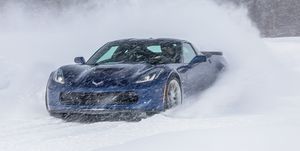Two-stroke engines aren’t dead. Well, they might be in cars, but they’re more alive than ever in snowmobiles. Forget the smoke-spewing, spark-plug-fouling, expletive-inducing engines of the past. Bombardier’s Rotax engine division builds modern two-strokes that are clean, efficient, and powerful. In the booming high-altitude mountain-snowmobile segment, the naturally aspirated engine struggle is real. Free-breathing engines turn from heroes to zeros in the thin air. That huffing noise is not only our flatlander lungs scavenging for oxygen, it’s also the sound of the first-ever factory gas-fed turbocharged two-stroke engine under the hood of a mountain-climbing 2020 Ski-Doo Summit 850 E-TEC Turbo snowmobile.
Our previous exposure to the brand’s 165-hp 849-cc inline-twin left us glowing. But that was near sea level. The problem with naturally aspirated engines is this: For every 1000 feet of elevation, the increasingly thin air robs roughly 3 percent of peak horsepower. By Ski-Doo’s calculation, the free-breathing two-stroke mill loses 40 horsepower at 8000 feet. However, the leaders in two-stroke innovation now have the ultimate solution: turbocharging.
Turbolicious
The boosting of two-strokes isn’t new. The aftermarket world has been offering the technology for some time. However, the systems can be finicky, require additional tuning, are expensive, and throw the factory warranty into the trash. Bombardier Recreational Product’s Rotax engine division saw the demand for more power, and they delivered.
Though sourcing a turbo from a supplier would’ve been the easy route, Rotax chose to develop the liquid-cooled and oil-lubricated compressor in-house. Instead of chasing a big horsepower number, Ski-Doo took a more conservative approach with the new 850 E-TEC Turbo. By carefully monitoring the engine’s operating parameters and the changing atmospheric conditions, the turbocharger’s variable waste gate enables up to 4.0 pounds of boost to maintain 165 horsepower from sea level all the way up to 8000 feet.
Above that altitude, on Yellowstone’s Two Top Mountain, the turbo model still outshines its unboosted sibling. A cleverly designed split intake tract lets the engine breath naturally until 6000 rpm, and as boost builds, a mechanical valve closes off the atmospheric intake to stuff the plenum with boost. While that may seem late, when you’re riding the Summit, 6000 to 8000 rpm is the normal operating range. And what a riot it is to ride. Its track is eager to saw through a story’s worth of fresh pow. The throttle response is immediate as turbo lag never shows its ugly face, giving the Summit Turbo the ability to claw its way to the top of the fluffy white gold with ease.
Unlike a typical automotive turbocharging system, notably missing is an intercooler. Ski-Doo justifies its absence by noting the complexity and additional weight it would take to cool the charge. And because these are snow machines, the short intake runners are always ingesting frigid air. If abnormal operation is detected, the advanced electronics can dial things back to protect the engine. The turbo system is clean and compact, and by Ski-Doo’s claim, only adds 10 pounds.
Start Me Up
Also of interest is the Summit 850 E-TEC Turbo’s lack of starter motor or battery. Imagine trying to free a baby elephant from quicksand. It would be an energy-intensive task. In the back country, burying a snowmobile in deep snow is an unavoidable event. To keep things lightweight, this mountain goat employs the brand’s SHOT starting system. The first start of the day requires tugging on the traditional pull-start cord. From there, the engine’s magneto acts as a generator, charging a lightweight ultra-capacitor in two minutes after a cold start. Subsequent starts after the initial pull are push-button, as the capacitor discharges into the magneto—now acting as a starter motor—and turns the crankshaft. Once the engine is warm, the capacitor is fully charged in just 20 seconds and can maintain a charge with the engine off for about 30 minutes. The SHOT system weighs a claimed two pounds, or 17 pounds less than a battery starting system. A trick starting system and a turbocharger ensures Ski-Doo’s reign as the real Rocky Mountain king.
Source: Reviews - aranddriver.com





